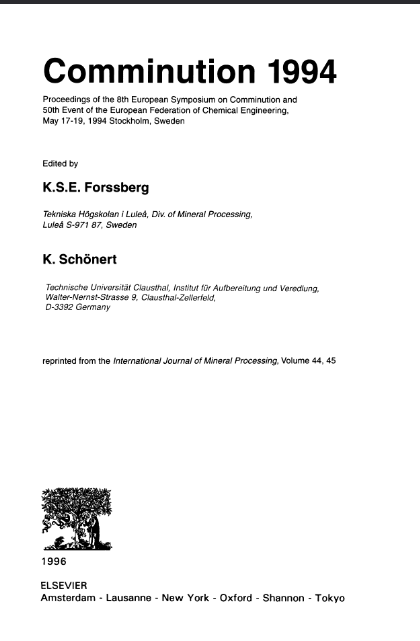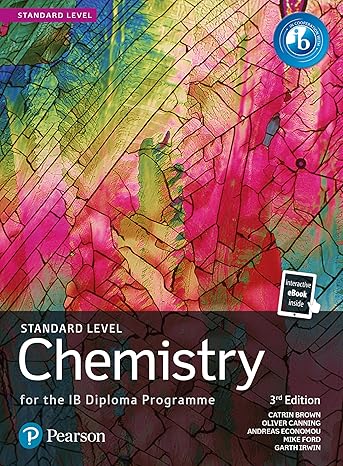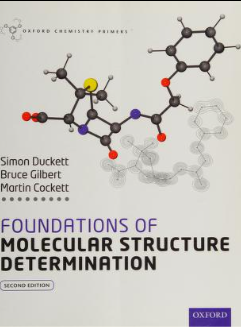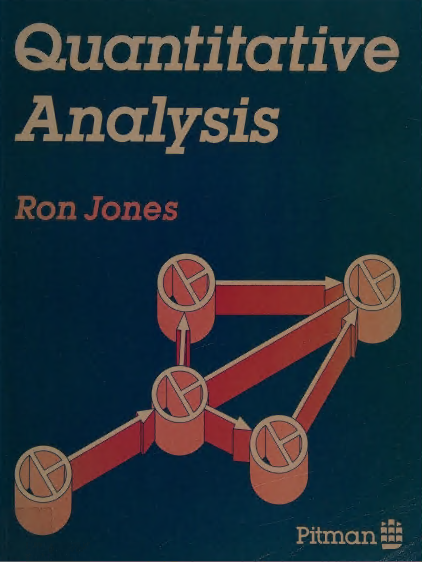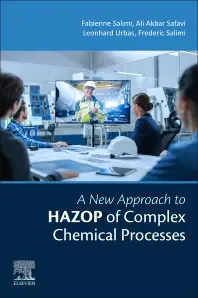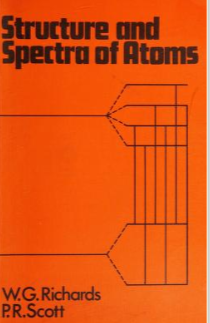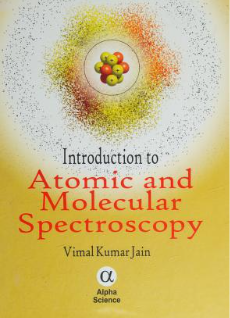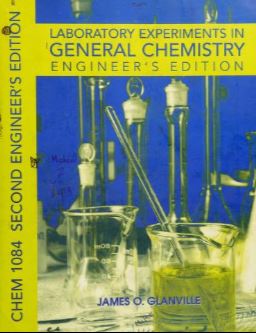Comminution 1994 Proceedings of the 8th European Symposium on Comminution and 50th Event of the European Federation of Chemical Engineering, May 17-19, 1994 Stockholm, Sweden Edited by K.S.E. Forssberg Tekniska Högskolan i Luleâ, Div. of Mineral Processing, Luleâ S-971 87, Sweden K. Schönert Technische Universität Clausthal, Institut für Aufbereitung und Veredlung, Walter-Nernst-Strasse 9, Clausthal-Zellerfeld, D-3392 Germany reprinted from the International Journal of Mineral Processing, Volume 44, 45 1996 ELSEVIER Amsterdam - Lausanne - New York - Oxford - Shannon - Tokyo ELSEVIER SCIENCE B.V. Sara Burgerhartstraat 25 P.O. Box 2 1 1 , 1000 AE Amsterdam, The Netherlands ISBN: 0-444-82440-5 © 1996 Elsevier Science B.V. All rights reserved. No part of this publication may be reproduced, stored in a retrieval system, or transmitted in any form or by any means, electronic, mechanical, photocopying, recording or otherwise, without the prior written permission of the publisher, Elsevier Science B.V., Copyright & Permissions Department, P.O. Box 5 2 1 , 1000 AM Amsterdam, The Netherlands. Special regulations for readers in the U.S.A. - This publication has been registered with the Copyright Clearance Center Inc. (CCC), 222 Rosewood Drive, Danvers, MA 01923. Information can be obtained from the CCC about conditions under which photocopies of parts of this publication may be made in the U.S.A. All other copyright questions, including photocopying outside of the U.S.A., should be referred to the copyright owner, Elsevier Science B.V., unless otherwise specified. No responsibility is assumed by the publisher for any injury and/or damage to persons or property as a matter of products liability, negligence or otherwise, or from any use or operation of any methods, products, instructions or ideas contained in the material herein. This book is printed on acid-free paper. Printed in The Netherlands minERm PROCESSIF inTERnRTionm JOURRRL OF ELSEVIER Int. J. Miner. Process. 4 4 - 4 5 (1996) ix Preface The planning of the 8th European Symposium started in 1990 when Stockholm was approved as venue by the Working Party Comminution, Agglomeration and Classifica tion of the European Federation of Chemical Engineering. The progresss was then discussed at subsequent meetings with the Working Party Comminution, Agglomeration and Classification who served as the scientific committee for the symposium. The organisation of the symposium was entrusted to the Division of Mineral Processing, Luleâ University of Technology, Sweden. All practical arrangements were taken care of by the Stockholm Convention Bureau in a professional manner. A program committee consisting of Klaus Schönert, Clausthal-Zellerfeld, Eric Forssberg, Luleâ and Dieter Redeker, Leverkusen was appointed. The 8th European Symposium on Comminution was supported by the Royal Swedish Academy of Engineering Sciences (IVA), the Swedish Mineral Processing Research Organisation (MinFo) and the Swedish Mineral Industry Research Organisation (MITU). Financial sponsoring from a large number of companies in Finland, Norway and Sweden was gratefully received. It was decided at an early stage to provide pre-prints of all papers at the symposium and to publish the papers after reviewing. An agreement was made with Elsevier to publish the papers in a special volume of the International Journal of Mineral Processing and as a hard cover volume. The persons who have reviewed the manuscripts have to remain anonymous, but deserve a hearty "thank y o u " for their efforts. Special thanks go to the authors for their contributions and for their promptness in returning the corrected manuscripts after receiving the reviewers' remarks. Finally, we want to thank Mrs. Siv Tewolde Berhan, Division of Mineral Processing, Luleâ University of Technology for her indefatigable efforts during the planning and organization of the symposium as well as during the reviewing process. Eric Forssberg Klaus Schönert Luleâ Clausthal-Zellerfeld Elsevier Science B.V. SSDI 0 3 0 1 - 7 5 1 6 ( 9 5 ' ) 0 0 0 8 1 - X ΙΠΤΕΒΠΠΤΙΟΠΠΙJOURHRL OF minERm PROCESSUS Int. J. Miner. Process. 4 4 - 4 5 ( 1996) 1-16 — The influence of particle bed configurations and confinements on particle breakage K. Schönert Institute of Mineral Processing, Technical University Clausthal, D-38678 Clausthal-Zellerfeld, Germany Abstract Particle arrangements and confinements can be classified in the four groups (1) single particle situation, (2) one-particle layer, (3) particle bed confined closely or widely, and (4) ideal particle bed. Any confinement influences the stress distribution inside the bed due to the wall friction, and a complex stress field arises. The size-reduction effect is represented with the fraction of broken particles, the breakage function and the specific surface increases. The breakage functions of the particle bed comminution display as truncated logarithmic normal distributions. The stressing intensity can be quantified by the pressure, the stress field characteristics or the energy absorption. Although the stress field situation can differ extremely, the overall energy absorption has been proven to represent the stressing intensity very well in respect to the size-reduction. The transition from a close to a moderately wide confinement does not affect the size-reduction strongly. Steel balls inserted in a particle bed improve the breakage of coarse particles at a low intensity level. This advantage fades with increasing intensity and decreasing particle size. 1. Introduction
چکیده فارسی
Comminution 1994 مجموعه مقالات هشتمین سمپوزیوم اروپایی در مورد خرد کردن و پنجاهمین رویداد فدراسیون اروپایی مهندسی شیمی، 17-19 مه، 1994 استکهلم، سوئد ویرایش شده توسط K.S.E. Forssberg Tekniska Högskolan i Luleâ, Div. of Mineral Processing, Luleâ S-971 87, Sweden K. Schönert Technische Universität Clausthal, Institut für Aufbereitung und Veredlung, Walter-Nernst-Strasse 9, Clausthal-Zellerfeld, D-3392 German Journal of Minternational Processing4, Reprinted from the International Processing4 , 45 1996 ELSEVIER Amsterdam - Lozanne - New York - Oxford - Shannon - Tokyo ELSEVIER SCIENCE B.V. Sara Burgerhartstraat 25 P.O. Box 2 1 1 , 1000 AE Amsterdam, The Netherlands ISBN: 0-444-82440-5 © 1996 Elsevier Science B.V. کلیه حقوق محفوظ است. هیچ بخشی از این نشریه را نمی توان تکثیر کرد، در یک سیستم بازیابی ذخیره کرد، یا به هر شکل یا با هر وسیله ای، الکترونیکی، مکانیکی، فتوکپی، ضبط یا غیره، بدون اجازه کتبی قبلی ناشر، Elsevier Science B.V., Copyright & انتقال داد. بخش مجوزها، P.O. جعبه 5 2 1، 1000 صبح آمستردام، هلند. مقررات ویژه برای خوانندگان در ایالات متحده آمریکا - این نشریه در مرکز تأیید حق چاپ (CCC) ثبت شده است. ممکن است در ایالات متحده ایجاد شود. همه سؤالات حق نسخهبرداری دیگر، از جمله فتوکپی در خارج از ایالات متحده، باید به مالک حق نسخهبرداری، Elsevier Science B.V. ارجاع شود، مگر اینکه طور دیگری مشخص شده باشد. ناشر هیچ مسئولیتی در قبال هر گونه آسیب و/یا آسیب به اشخاص یا اموال به دلیل مسئولیت محصولات، سهل انگاری یا موارد دیگر، یا استفاده یا عملیاتی از هر روش، محصول، دستورالعمل یا ایده ای که در مطالب موجود است، نمی پذیرد. این کتاب بر روی کاغذ بدون اسید چاپ شده است. چاپ شده در هلند minERm PROCESSIF internRTionm JOURRRL OF ELSEVIER Int. جی. ماینر. روند. 4 4 - 4 5 (1996) ix مقدمه برنامه ریزی هشتمین سمپوزیوم اروپایی در سال 1990 آغاز شد، زمانی که استکهلم به عنوان محل برگزاری توسط کارگروه خرد کردن، تجمع و طبقه بندی فدراسیون اروپایی مهندسی شیمی تصویب شد. سپس پیشرفت ها در جلسات بعدی با کارگروه خرد کردن، تجمع و طبقه بندی که به عنوان کمیته علمی سمپوزیوم خدمت می کرد، مورد بحث قرار گرفت. سازماندهی سمپوزیوم به بخش فرآوری مواد معدنی دانشگاه فناوری لوله سوئد سپرده شد. تمام ترتیبات عملی توسط دفتر کنوانسیون استکهلم به شیوه ای حرفه ای انجام شد. کمیته برنامه متشکل از کلاوس شونرت، کلاوستال-زلرفلد، اریک فورسبرگ، لوله و دیتر ردکر، لورکوزن منصوب شد. هشتمین سمپوزیوم اروپایی در مورد خردایش توسط آکادمی سلطنتی علوم مهندسی سوئد (IVA)، سازمان تحقیقات فرآوری مواد معدنی سوئد (MinFo) و سازمان تحقیقات صنایع معدنی سوئد (MITU) حمایت شد. حمایت مالی تعداد زیادی از شرکت ها در فنلاند، نروژ و سوئد با سپاس پذیرفته شد. در مراحل اولیه تصمیم گرفته شد که در سمپوزیوم پیش چاپ کلیه مقالات ارائه شود و پس از بررسی مقالات منتشر شود. با الزویر توافق شد که مقالات در جلد ویژه مجله بین المللی فرآوری مواد معدنی و به صورت جلد سخت منتشر شود. افرادی که نسخههای خطی را بررسی کردهاند باید ناشناس بمانند، اما سزاوار یک «متشکرم» صمیمانه برای تلاشهایشان هستند. تشکر ویژه ای از نویسندگان به خاطر مشارکت آنها و سریع بودن آنها در بازگرداندن دست نوشته های تصحیح شده پس از دریافت نظرات داوران. در پایان، ما می خواهیم از خانم Siv Tewolde Berhan، بخش فرآوری مواد معدنی، دانشگاه صنعتی Luleâ به دلیل تلاش های خستگی ناپذیر او در طول برنامه ریزی و سازماندهی سمپوزیوم و همچنین در طول فرآیند بررسی، تشکر کنیم. اریک فورسبرگ کلاوس شونرت Luleâ Clausthal-Zellerfeld Elsevier Science B.V. SSDI 0 3 0 1 - 7 5 1 6 ( 9 5 ' ) 0 0 0 8 1 - X ΙΠΤΕΒΠΠΤΙΟΠΠΙJOURHRL OF minERm PROC. جی. ماینر. روند. 4 4 - 4 5 (1996) 1-16 - تأثیر پیکربندیها و محصورات بستر ذرات بر شکستگی ذرات K. Schönert Institute of Mineral Processing, Technical University Clausthal, D-38678 Clausthal-Zellerfeld, Germany چکیده آرایش و محدودیت ذرات را می توان در چهار گروه (1) وضعیت تک ذره، (2) لایه یک ذره، (3) بستر ذرات محدود یا به طور گسترده، و (4) بستر ذرات ایده آل طبقه بندی می شوند. هر گونه محصور شدن بر توزیع تنش در داخل بستر به دلیل اصطکاک دیوار تأثیر می گذارد و یک میدان تنش پیچیده ایجاد می شود. اثر کاهش اندازه با کسر ذرات شکسته نشان داده می شود، عملکرد شکست و سطح ویژه افزایش می یابد. توابع شکست صفحه نمایش خرد شدن بستر ذرات به صورت توزیع نرمال لگاریتمی کوتاه شده. شدت تنش را می توان با فشار، ویژگی های میدان تنش یا جذب انرژی تعیین کرد. اگرچه وضعیت میدان تنش میتواند بسیار متفاوت باشد، اما ثابت شده است که جذب انرژی کلی شدت تنش را در کاهش اندازه به خوبی نشان میدهد. انتقال از یک محفظه نزدیک به یک حصار نسبتاً گسترده تأثیری بر کاهش اندازه ندارد. توپهای فولادی که در بستر ذرات قرار میگیرند، شکستگی ذرات درشت را در سطح شدت پایین بهبود میبخشند. این مزیت با افزایش شدت و کاهش اندازه ذرات محو می شود. 1. مقدمه
ادامه ...
بستن ...
ELSEVIER SCIENCE B.V.
Sara Burgerhartstraat 25
P.O. Box 2 1 1 , 1000 AE Amsterdam, The Netherlands
ISBN: 0-444-82440-5
© 1996 Elsevier Science B.V. All rights reserved.
No part of this publication may be reproduced, stored in a retrieval system, or transmitted in any form or
by any means, electronic, mechanical, photocopying, recording or otherwise, without the prior written
permission of the publisher, Elsevier Science B.V., Copyright & Permissions Department, P.O. Box 5 2 1 ,
1000 AM Amsterdam, The Netherlands.
Special regulations for readers in the U.S.A. - This publication has been registered with the Copyright
Clearance Center Inc. (CCC), 222 Rosewood Drive, Danvers, MA 01923. Information can be obtained
from the CCC about conditions under which photocopies of parts of this publication may be made in the
U.S.A. All other copyright questions, including photocopying outside of the U.S.A., should be referred to
the copyright owner, Elsevier Science B.V., unless otherwise specified.
No responsibility is assumed by the publisher for any injury and/or damage to persons or property as a
matter of products liability, negligence or otherwise, or from any use or operation of any methods,
products, instructions or ideas contained in the material herein.
This book is printed on acid-free paper.
Printed in The Netherlands
ادامه ...
بستن ...
